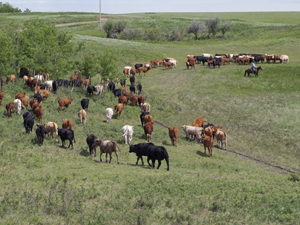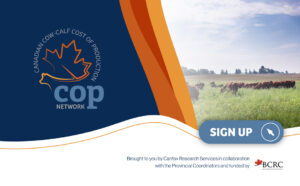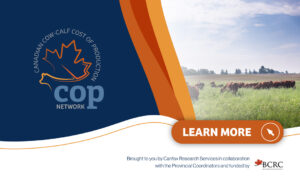Networks Make The Dream Work
Remarque : cette page web n’est actuellement disponible qu’en anglais.
This is Part Two of a three-part series (see Part One and Part Three).
Editor’s note: this article is also available in French. Download the translated version here.

As the industry has been rocked by COVID-19, volatile market prices and uncertainty have occurred. There is an opportunity for producers to examine what they can control – their cost of production. During the boom years when prices are high it is easy for costs to get out of hand. You may be considering changes to your operation but are not sure where you will get the biggest bang for your buck.
The Canadian Cow-Calf Cost of Production Network (CDN COP Network) will develop benchmarks for specific production systems and ecoregions across the country. Scenarios will be developed for what future farms could look like utilizing the 5% Rule to identify where incremental improvements could be made around productivity, input costs, and output prices. Each production system will have its own set of opportunities, limitations, and areas where greater focus may be beneficial. Consider cattle operations with different production systems:
- A beef operation in the east is considering raising dairy-beef but is uncertain about the costs and management changes needed to succeed.
- A small, land-locked operation may be utilizing multiple income streams from multiple different commodities to manage risk. The focus is on using each acre in different ways throughout the year to generate revenue.
- A large, specialized operation may be focused on economies of scale in purchases and sales and efficiencies in labour productivity.
When looking at competitiveness and profitability, each region needs to evaluate the limitations and opportunities unique to them. Is land, labour, or capital the limitation? Will the biggest impact for the operation come from reducing input costs, or improving productivity, or increasing price?
Producers participating in the CDN COP Network focus groups will be encouraged to network as a way to support achieving future farm goals over the next three to five years. Networks are a powerful tool for both learning and accountability. They create a group of people who can brainstorm new areas of innovation and help troubleshoot when implementation of a new practice maybe isn’t going as planned. While the network will primarily benefit those who are directly involved; the benchmarking and lessons learned in community through the network will also support industry competitiveness by fostering a mindset that values continuous improvement through exploration of new innovations and management practices.
Producer Networks
Engaging in a network of like-minded producers can be transformative. In today’s marketplace, increasing importance is placed on networking with people inside and outside of the industry to uncover opportunities to connect with different types of producers and experts. Anyone in isolation is limited in their ability to learn about new and innovative management practices or to respond to changing market conditions. Networks create opportunities for engagement and connection without eliminating the autonomy of individual units within the network (Holmlund and Fulton 1999). The opportunity to further develop areas of expertise can be hugely positive for both individual producers and the industry as a whole.
A problem shared, is a problem halved ~ Unknown
Knowledge transfer does not have to be top down. It can, instead, be shared between all of those who are part of the production process. Michael Bohlje (1996) noted “Farmers have generally been eager to try new hybrids, new chemicals, new tillage practices, new feeding regimes and new equipment, but new ways of doing business have met with more resistance, possibly because they change relationships and frequently substitute interdependence for independence in the decision-making process.”
Why join a network?
The “Dollars and Sense” report (2016) found that continuous learning topped the list farm management practices that contributed to financial success. Part of what made some farms successful was accessing networks in an effort to source new information. These networks included focus groups, educational institutions, and conferences. Farms in the bottom quartile were found to be three times more likely to not seek out new information, training or learning opportunities. Effective management equals financial success and part of good management is seeking out the expertise of others.
What makes a Network effective?
Networking, when successful, gives everyone the opportunity to learn and benefit (Holmlund and Fulton 1999). The value that is created by a network is “by increasing the size of the ‘pie’ and then benefiting from this larger pie” (Fulton and Sanderson 2003, p.19). Improved competence is gained through the exchange of information, skills, knowledge, experience through meetings, publications, and cooperative programs. All members of the network will benefit, whether individuals or organizations (Starkey 1996).
By bringing together producers, networks prevent the duplication of work and effort in a cost-effective way that can have a larger impact and faster progress than individuals acting on their own. The benefits of networking include: leverage, information exchange, mitigation of risk, and greater opportunities for integration of efforts across the production chain (Dunn, 1997). The end result of these linkages is a framework with the knowledge and adaptability to support the long-term future of the beef industry.
Linking people with different perspectives, knowledge, disciplines, organizations, and backgrounds empowers them. This allows producers to take more control of their industry and shape the development process. Changing weather patterns, regulations, technology and markets are contributing to changes in how farmers frame knowledge and determine what is legitimate. These forces are “increasing their receptiveness to, and reliance on, others’ knowledge.” In a rapidly changing world, farmers that are receptive to the know-how and know-who that others may offer as information has become increasingly salient.
“If you want to go quickly, go alone. If you want to go far, go together.” ~African proverb
More Benefits for Producers
Networks facilitate the transfer of knowledge from one generation of producers to another. As we look at the number of operations that will be going through inter-generational change over the coming decade, the CDN COP Network provides opportunities for new entrants to learn from those who face similar environmental conditions and have similar production systems.
Successful networks such as the Ontario Soil Network help to create awareness, connecting like-minded producers and helping create a platform through which they can share questions and insights. This platform helps foster a sense of community and assurance that the industry is moving forward and adapting to changes in technology and markets.
In addition to generating and exchanging knowledge based on producers’ experiences, networks can facilitate technical cooperation. This can be hugely beneficial in tackling challenges and providing producers with appropriate resources.
Benefits for the Research Community
They also encourage collaboration between researchers and producers. Bosma et al., (2003) highlighted this aspect of group data collection. Meetings with farmer focus groups have been shown to help establish a relationship between researchers and farmers, allowing for more accurate collection of farm data. A final group meeting at the end of the project provides researchers a chance to present study results and incorporate farmers’ feedback, identifying relevant new research topics and potential policy initiatives. It also provided an opportunity for farmers to share experiences and market information with each other.
Bringing together producers can help researchers learn about what works or doesn’t on farm, further refining research priorities. Van Passel and Meul (2010) selected 14 dairy farms to evaluate the ecological sustainability of the farms as well as their economic sustainability. During the focus group discussions which included both farmers and experts, new opportunities were created for potential individual action plans to be discussed between producers and experts. It was noted that awareness of issues around sustainability can be improved through integrated information sharing and the development of concrete tools for measuring and promoting achievements.
 The Canadian Cow-calf Cost of Production Network
The Canadian Cow-calf Cost of Production Network
Data collection is scheduled for January to March 2021, provided that small groups of ten people can meet safely in the province. We are looking for 156 producers to sign up; there will be a $500 honorarium for each farm participating.
The CDN COP Network is going to provide the baseline data for the Canadian Roundtable for Sustainable Beef’s updated economic assessment of the Canadian beef industry. Therefore, anyone who signs up will not only be benefiting from the networking opportunity for their own operation but also contributing to this industry commitment as we learn from each other.
NEXT IN THE SERIES: A New Approach to Cost of Production Benchmarking
- References
- Behlje, M. 1996. “Industrialization of Agriculture: What are the Implications?” Choices Fourth Quarter: 30-33.
- Dunn, B.H. 1997. “Networking People”. Range Beef Cow Symposium. 157. https://digitalcommons.unl.edu/rangebeefcowsymp/157.
- Holmlund, M. and M. Fulton. 1999. Networking for Success: Strategic Alliances in the New Agriculture. Saskatoon: Centre for the Study of Co-operatives, University of Saskatchewan.
- Fulton, M. and K. Sanderson. 2003. Co-operatives and Farmers in the New Agriculture.
- National Farm Business Management Resource Centre. “Dollars and Sense Report,” June 17, 2016. http://takeanewapproach.ca/2016/06/17/dollars-and-sense-report/.
- Starkey P. 1996. Networking for sustainable agriculture: Lessons from animal traction development. Gatekeeper Series 58. IIED, London.
- Thomas, E., M. Riley, and J. Spees. 2020. “Knowledge Flows: Farmers’ Social Relations and Knowledge Sharing Practices in ‘Catchment Sensitive Farming.’” Land Use Policy 90 (January 1, 2020): 104254. https://doi.org/10.1016/j.landusepol.2019.104254.
- Van Passel, S., and M. Meul. 2013. “Multilevel and Multi-User Sustainability Assessment of Farming Systems.” In Methods and Procedures for Building Sustainable Farming Systems: Application in the European Context, edited by Ana Alexandra Marta-Costa and Emiliana L. D. G. Soares da Silva, 63–88. Dordrecht: Springer Netherlands. https://doi.org/10.1007/978-94-007-5003-6_6.
Click here to subscribe to the BCRC Blog and receive email notifications when new content is posted.
The sharing or reprinting of BCRC Blog articles is welcome and encouraged. Please provide acknowledgement to the Beef Cattle Research Council, list the website address, www.BeefResearch.ca, and let us know you chose to share the article by emailing us at info@beefresearch.ca.
We welcome your questions, comments and suggestions. Contact us directly or generate public discussion by posting your thoughts below.
